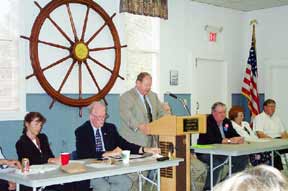|
|
This Week's Articles
(click on the link to jump to the artical)
Help Wanted: Volunteers Needed to Comb Our Coasts for Garbage
When you’re walking on the beach, the handful — or pack — of cigarette butts beneath your toes isn’t the half of it. Imagine stomping through over a million and a half burned-out butts.
 |
photo courtesy of Academy of Natural Sciences Estuarine Research Center
Cleanup volunteers worked with the Academy of Natural Sciences Estuarine Research Center to pick up all this coastal trash at Jefferson Patterson Park.
|
To make a dent in the litter on the world’s waterways, volunteers from around the world will be gathering on beaches on or about September 21 for the Ocean Conservancy’s 17th annual International Coastal Cleanup.
The International Coastal Cleanup is the oldest and largest volunteer cleanup effort on Earth, mobilizing 4.7 million people since 1986. Every major body of water on the planet has benefited from the cleanup, with 118 countries and all 55 U.S. states and territories joining in.
Last year, three-quarters of a million volunteers from 77 countries picked up 12.5 million pounds of trash while combing over 12,000 miles of beaches and waterways. Their haul included 1,527,837 cigarettes and cigarette filters, 933,856 bags and food wrappers, 541,432 caps and lids and 448,759 plastic beverage bottles from both land and underwater. Other Top Ten items included dishware, beverage cans, glass beverage bottles, plastic straws and stirrers, fast-food containers and fishing nets.
All that junk is more than a mess. It’s a deadly hazard to which animals are especially susceptible as they become entangled in discarded fishing line or when they swallow plastic bags. Last year, 125 animals were found entangled by Coastal Cleanup volunteers. Marine debris can drown, smother, poison and severely injure fish, birds, dolphins, whales, manatees and seals.
We’re all part of the problem, with Americans producing far more than our share of garbage.
In Chesapeake Country, the International Cleanup is moving inland from the ocean to pick up the problem.
“We do a big cleanup on Assateague Island,” said Joyce Ponsell, director of the Assateague Coastal Trust, which has pitched in on cleanup day for a decade. Her organization’s longevity has earned her the responsibility of coordinating the “whole thing” in Maryland.
“It’s grown like Topsey as more and more people signed on, in Cambridge, Easton and with the state parks,” Ponsell said.
Growth has been slower on our shore, as distance has made it difficult to find willing coordinators.
In Calvert County, the Academy of Natural Sciences Estuarine Research Center at St. Leonard is the oldest partner, staging its third cleanup this September. This year two new partners will join in cleaning up our Western Shore. Sandy Point State Park holds a cleanup September 7, followed by the National Aquarium at Baltimore’s cleanup at Fort McHenry September 21.
Working with the Estuarine Research Center at six locations, including North Beach, last year 91 volunteers hauled 49 bags of trash off 8.5 miles of beach. Too big to bag were 27 tires, one hot water heater, one motor and lots of treated wood and metal strips.
Center Education Coordinator Lloyd Jenkins is looking for helpers for this year’s cleanup at Kings Landing in Calvert County and Greenwell State Park in St. Marys. If you’re a Scout, service club or friend of the Bay, lend a hand.
Information? Estuarine Research Center: 410/586-9700 • Sandy Point Cleanup: 301/650-0617 • Assateague Coastal Trust/Maryland Cleanup: 410/629-1538 • Ocean Conservancy: 800/262-beach.
— Katie McLaughlin
Return to the top
Earth Journal ~ Birds of a Strange Summer
These are the mad-dog days of summer, I grumble, as I sit on my porch on a sweltering afternoon and watch strange beetles creep dazedly from fissures in my sun-baked yard. They are big insects the color of dull jade and marked with burnished gold. Are they simply cicadas in a stage I am unfamiliar with? Or are they mutant harbingers of Armageddon?
The butterflies in my garden seem fragile and faded as old quilt blocks. The perennials along the fence are deformed by drought and vicious winds. The blue basil I planted last year has returned in the guise of lilac bergamot, which is okay with me because that wild fragrant herb is what I wanted in the first place but couldn’t find it anywhere in spring. My garden consultant tells me the basil may have “morphed.” That is a scarey thought. But who am I to question it? It has been that kind of summer.
Over in the corner of the yard the old apple tree is amazingly green despite the heat. Beneath the spreading boughs is a birdbath and a damp patch of periwinkle vines where lives a box turtle. It is a magical tree, a haven of rarities. One winter it hosted a flock of yellow grosbeaks, in another, dozens of flower-eating golden waxwings during a late snowfall.
Suddenly there is a flurry of birds in and out of the boughs. A crazed mockingbird — the neighborhood terrorist — is stirring up trouble. He screams and all the other birds fly about hysterically. So I rush to see what is going on, expecting to find one of their own in crisis.
 |
| photo by Merrill Scharmen |
A false alarm, I mutter, as the birds flee and all becomes very quiet. I pause to peer up into the canopy of tangled branches. There, staring back at me, only a few feet above, is a trio of fuzzy grey owlets. Three cunning catlike faces with enormous yellow eyes. One swivels its head constantly as if it has just discovered how to do it, and I am Alice in Wonderland. Nearby, a russet-hued parent, handsomely feathered and with tiny white horns, keeps one eye on the brood and the other on me. She is only slightly larger than the petite babes. (My intuition told me she is female.)
I am seeing something unique. Little screech owls. My first. I have since learned that they are congenial, can see in brightest sunlight, are fond of water and have been seen batheing in backyard birdbaths. They like apple trees and eat cicadas. So!
Whatever has drawn them, I will them to stay. It is the sort of neighborhood I would choose to nest in if I were an owl. It is close and cluttered. There are few tall trees, some of which have been altered by recent development. But it is a peaceful peninsula surrounded by water and there is a perfect dead hollow tree across the lane, thoughtfully spared by the new owner of the property. The owls may have been born there on the shore.
I summoned my friend, my roomie, to snap photos and assist with an interview with the little cat-owls. (That is one of many colloquial names for them.) They moved confidently about the boughs during the afternoon, and the parent eventually assumed a position (of annoyance?) on the trunk of the tree where she resembled a perfect carving, so rigid was she. Toward dusk, she grew restive and the family conversed in soft trills and tremulous purrs as they gathered together and flew off into the afterglow of sunset.
The babes returned, alone, a few nights later, pausing curiously at the backyard birdbath and perching briefly on the eave of our house. Lightning flickered on the western horizon as the sky darkened. A molten-gold moon, one night from full, rose determinedly over the trees in a race with gathering clouds. As a long-awaited rain moved in, the moon disappeared with the owls.
The owls have not come again. But they are near. I have heard their shrill little cry in the pre-dawn stillness of the creek shore. Sometimes I step outside to answer.
— Audrey Y. Scharmen
Return to the top
What to Do with 30+ Tons of 460-Year-Old Wood
 |
| scratchboard by Gary Pendleton |
The 460-year old Wye Oak will live on in many forms. Within three months of the beloved tree’s June 6 knockdown, 520 inspired citizens have responded to the Wye Oak Advisory Committee’s call for innovative ideas on how to use the tree’s remains.
It is a very long list, extending to every part of the fallen oak tree, including bark, stems, twigs, leaves and decaying material — all of which, the committee concluded, can be used for education, research, display, artwork or souvenirs.
Topping the list of suggestions are furniture, sculpture, souvenirs and memorial items for September 11. Profits from sales, many thought, should support conservation and preservation.
Suggested in the not-for-profit vein were furniture and display items for the Maryland State House, counties and museums, as well as commemorative objects for awards and special recognition of citizens.
Big-thinking citizens suggested building a skipjack and a large sculpture depicting Maryland’s history and its residents over 460 years. Art-lovers imagined all sorts of small sculptures: decoys, bald eagles, black bears, Wye oaks, boat models, a bust of each Maryland governor, a carving dedicated to Native Americans. A tree-lover suggested a large monument to honor all trees lost to development.
Still others want to keep the trunk intact for display. That fragment, called the bole, weighs 30 tons.
The bole has been stripped of the asbestos and concrete used over the years to strengthen the standing tree. Stored in the Bay Model Warehouse on Kent Island, it must still be fumigated for insects. Wood experts from the Smithsonian determined that the warehouse is a “perfect” location because the high temperatures in the metal building are drying the bole as if in a low-level kiln. If the wood is to be sculpted, it must first dry for 5 to 10 years.
Experts called in to preserve the tree and its parts say that primary-branch wood in various lengths — complete with metal bracing and rot — is likely to survive only six months in the warehouse. Only one percent of the rest of the tree is suitable for cutting into lumber. Twigs, leaves and about 80 cubic yards of miscellaneous tree material make up the remainder.
Leaves were collected in bags within 24 hours and stored in coolers at the state nursery. Some were distributed to experts for preservation to be dipped in metal, to undergo a copper coating process, and delivered to The Annapolis Pottery so leaf impressions could be preserved in pottery form. About 50 feet of cable wire was also catalogued in the tree inventory and saved.
With many parts of the tree safeguarded and so many ideas in hand, Wye futures move to another stage. The state does not have resources to fund, staff or manage this process, the committee concluded. So they recommend a Request for Expression of Interest to formalize submission of ideas and solicitation for uses of the Wye Oak material. Then they’ll dig in.
— Flo Ormond
Return to the top
Voters Match up Candidates in Galesville
Across the country, Republicans from Limbaugh to the Log Cabin Club are debating what issues the GOP should parlay this political season.
Last week, Anne Arundel Republicans seemed to have found their theme: You Democrats have had enough.
They wove it in and out of their pitches for a seat in the General Assembly’s 30th District, where all three seats in the House and one in the Senate are currently occupied by Democrats.
“Not one of the four [Democratic incumbents] is a bad person or has a bad record,” said Republican senatorial hopeful Nora Criss-McIntire Keenan. “But I believe in a two-party system.”
Keenan was among 19 candidates speaking at the Galesville Memorial Hall in a forum sponsored the Shady Side Peninsula Association, the South County Chamber of Commerce and the West River Improvement Association. The gathering drew aspirants for offices that ranged from county council (Seventh District) and executive to state delegate and senator (30th District).
 |
Republican Dave Wayson, standing, running for County Council in Anne Arundel’s District Seven, speaks at a candidates’ forum in Galesville.
photo by Sandra Martin
|
The event was among few shared forums leading up to Maryland’s primary election on September 10. On that day, Republicans and Democrats will choose their candidates to run in November’s general election. Independents can also vote in the Republican primary.
Nearly 100 people crowded the white clapboard village hall at the peak of the three-and-a-half-hour gathering. Abandoning climate-controlled homes in Churchton, Davidsonville, Fairhaven, Mayo, Shady Side, Tracys Landing and West River to gather on this sultry summer night had its rewards. While sipping iced tea and nibbling desserts, the audience got to ask questions of their own as well as hearing pitches from candidates.
But Republicans time and again turned their answers to the theme of our turn now.
Some played the soft pedal. “The whole idea of a citizen legislature is that people come in and out of government,” said Mike Collins, a Naval Academy graduate and political newcomer.
Others hit it hard. “Maryland is a one-party state,” said Andy Smarick, who must beat Keenan before he can have a go at Democratic incumbent Sen. John Astle. “And this one-party state gave us a billion-dollar deficit.”
“Demagoguery,” countered Democratic Del. Dick D’Amato, who had served his own time at the Naval Academy. D’Amato is now seeking a second four years in Maryland’s General Assembly, an institution he praised as “very successful,” where members “cooperate across party lines in a real attempt to solve problems.”
When no Democrats came to hand, Republicans turned their complaints against one another. County Executive Janet Owens had not accepted her invitation to take the Galvesville stage, leaving the two Republican hopefuls to best one other.
Which led Tom Angelis to growl at opponent Phil Bissett a warning that translated, roughly, as don’t upstage me. In mock generosity, Bissett had “yielded my remaining time to my opponent,” when he stopped his opening remarks a few seconds before his three minutes were up.
But the hour was late, and the long, hot night had taken much of the sizzle out of this one-on-one race that, with its sharp differences of personality and politics, has become one of the most interesting of the primary season.
For many candidates, aspirations live and die in the nine weeks of primary season. On September 11, seven of this night’s candidates will go back to being school teachers, retirees, community activists, economists and jet pilots. But tonight they shared the stage — and their audience — with the pros. In every man and woman’s hour on the stage, the Galesville audience applauded each equally, paying tribute to their pluck more than sense, style or substance.
“It was good to put faces to the names,” said Holly Clark of Galesville.
Then, gratefully, everybody went home, most to sort through what they’d heard.
— SOM
Return to the top
Way Downstream …
In Pennsylvania, the paltry flows in the Susquehanna River due to drought won’t be flushing much water into Chesapeake Bay. The flow at Wilkes-Barre measured less than half its usual 2,400 cubic feet per second, and forecasters don’t see much in the future to bolster volume in the Bay’s source …
In Virginia, a $300,000 grant from the Agriculture Department will help the Virginia Institute of Marine Science investigate the lineage of clams in hopes of breeding varieties that are bigger and more resistant to disease. A wonderful headline in the Daily Press this week told the story: “Scientists will be asking clams: Who’s your daddy?”
In Paris, people are flocking to the beach. What beach, you ask? Why, it’s the beach created when Bertrand Delanoe, the city’s Socialist mayor, imported palm trees and thousands of tons of sand to the banks of the River Seine. Over two million people have flocked to the “beach,” which is located near the Louvre, proving that Delanoe is not as wacky as people believed …
In Australia, a new offensive begun by authorities tells much of the story. Operation Mutant was begun last week to combat a mutant seaweed that the down-under continent says has begun wreaking environmental devastation. They’re dumping copper sulfate on the villain, Caulerpa taxifolia — also known as “killer algae” — which spreads so fast that it smothers all other native sea grasses …
 Our Creature Feature comes from the Czech Republic, where authorities finally have located a lost hippo. How the heck did they lose a creature that weighs a ton? The floods plaguing Europe did it, carrying 18-year-old Slavek out of his enclosure at the Prague Zoo and eventually into the second floor of a pavilion where he was just found Our Creature Feature comes from the Czech Republic, where authorities finally have located a lost hippo. How the heck did they lose a creature that weighs a ton? The floods plaguing Europe did it, carrying 18-year-old Slavek out of his enclosure at the Prague Zoo and eventually into the second floor of a pavilion where he was just found
Zookeepers were more thrilled than Slavek. “He’s quite hungry, and therefore quite angry. He was in attack mode,” head zookeeper Petr Feik told Reuters.
Copyright 2002
Bay Weekly
|